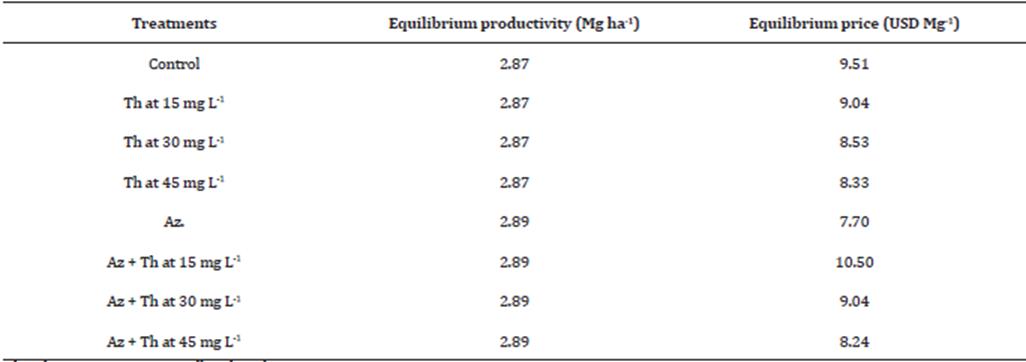INTRODUCTION
The exploration of different crops in a single property reduces the effect of the price oscillation paid to the farmer, especially in small and medium farms, where higher value crops should be preferred to optimize the area under cultivation. Among several species, sweet maize (Zea mays convar saccharata var. rugosa) is a crop that can be used with positive rates of profitability 1.
In contrast to the conventional maize used for grain production, sweet maize demands greater investments in manual harvesting, since its harvest is carried out when ears still in the field, with high moisture contents in the grains. This characteristic of management results in residual green plants in the field after ears harvest. When preparing the soil for planting a new crop, these plants are incorporated into the soil as green manure or kept as straw on the soil surface. It is also observed the possibility of the utilization of these plants as raw material for silage production 2, generating extra income for the producer. However, there are no scientific research about this economical thematic.
In addition to the high value crops exploration, the possibility of using new technologies, aimed at increasing the quality of the material produced, can be considered. In this perspective, it is observed the introduction of diazotrophic bacteria, which can perform the biological fixation of atmospheric nitrogen in grasses, through the enzyme nitrogenase 3, culminating in positive growth effect on maize plants, for example 4. It is also observed that the inoculation with these bacteria is a low-cost technique, when its participation in the total operational cost of production is verified 5,6.
Besides the diazotrophic bacteria, in recent years, compounds of a protective and biostimulating action has also been introduced. These compounds are used to maintain or increase the quality of the products. Vitamins, especially thiamine, still poorly explored in this field, although studies have shown that, these compounds have activities related to the production of secondary metabolites and even the expression of genes which act to protect plants 7. Also, the exogenous application of thiamine increases nutrient and energy reserves 8,9, which can be used for the development and maintenance of plant metabolic activity during periods of stress 10.
Although both technologies have positive effects on the cultures to which were applied, it was worked with the hypothesis that there is an interaction between them, due to their characteristics, endophytic presence of the bacterium and the protective action of the vitamin. The objective of this study was to evaluate the productivity, sweet maize plants characteristics, crude protein and economic indicators of the production of sweet maize silage inoculated with Azospirillum brasilense and thiamine as seed treatment
MATERIAL AND METHODS
Experimental conditions. The study was carried out in the experimental area of the Agronomy School, at the Federal University of Goiás, located in the city of Goiânia, Goiás State, Brazil (latitude 16°40'S, longitude 49°15'W and altitude of 750 m). This region has an Aw climate, according to KÖPPEN-GEIGER classification 11. The soil present in the experimental area was classified as Latossolo Vermelho distroférrico 12 and through laboratory chemical analysis 13 were observed the following characteristics: Ca2+: 3,5 cmolc dm-3, Mg2+: 1,80 cmolc dm-3, K+: 120,0 mg dm-3, P (Mehlich I): 7 mg dm-3, Organic matter: 16 g kg-3, Al3+: 0,0 cmolc dm-3, H+Al: 1,1 cmolc dm-3, pH (CaCl2): 6,4, CTC: 6.71 cmolc dm-3, V: 84%.
The granulometric analysis of the soil presented 450 g kg-1 of clay in the 0-0.2 m layer.
The climatic records of temperature and relative humidity, which occurred during the experiment conduction, were obtained from an evaporimetric station installed 100 m from the experimental area (Figure 1).
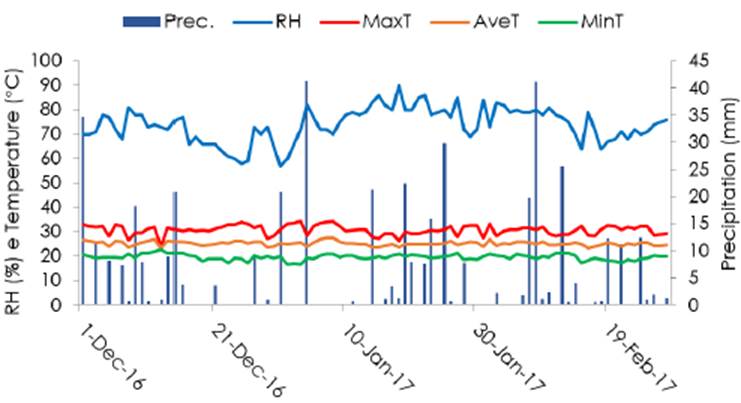
Figure 1 Climatic conditions of, precipitation (Prec.), relative air humidity (RH) and maximum (MaxT), average (AveT) and minimum (MinT) temperature during the conduction of the experiment.
Experimental desing. It was used a randomized block design, in a 2x4 factorial, totaling eight treatments, corresponding to the combination between inoculation with 10 mL of Azospirillum brasilense kg-1 seeds (with or without) and treatment with different doses of thiamine via seed (0, 15, 30 e 45 mg kg-1), in three repetitions. Each experimental plot consisted of an area of 10.00 m2, five lines of 4.00 m in length spaced 0.50 m apart.
Conduction of the experiment. The spontaneous plants in the area were desiccated with glyphosate-based herbicide (48% i.e.) one week before sowing. On December 1st of 2016 sweet maize (cv. BRS Vivi) was sowed in a planting space of 0.30 x 0.50 m, between plants and between lines, respectively, totaling a population of 66,700 plants ha-1.
For cover fertilization, 50 kg ha-1 N at 15 and 45 days after sowing were applied (urea 46% N). A single dose of KCl (60% K), equivalent to 40 kg ha-1 K2O, was applied together with the second nitrogen application. During the cycle, a single application of insecticide based on LAMBDA-CIALOTRIN (50% a.i.) was carried out to control Spodoptera frugiperda at 43 days after sowing.
Evaluation. When was observed a 30% humidity content in plants (R4 stage), the morphological components of plant height, stem diameter, fresh and dry mass productivity, dry mass content and crude protein content in the dry mass were evaluated. The plant height was measured with a measuring tape, measuring the height from the plant lap to the last leaf insertion, the stem diameter was measured with a digital caliper, measuring the plant stem at 10 cm above of the soil surface, both determinations made in ten plants per plot.
For determination of the fresh weight productivity, it was carried a manual cutting of ten plants per plot, 20 cm from the ground and then chopped in a stationary shredder with an average particle size of two centimeters, thus obtaining the whole plant forage at the silage point. After plants harvest, they were immediately weighed to determine the green mass yield. A portion of the homogenous and representative crushed mass was packed in paper bags, weighed and dried in a forced air oven at 65°C until a constant mass was obtained to determine the dry mass. Productivity was estimated for Mg ha-1. The crude protein content was determined by the Kjeldahl method (nitrogen content (NC) x 6.25), according to the methodology described by Silva and Queiroz 14.
To determine the production cost of sweet maize silage, the total operational cost (TOC) structure was used 15. The TOC is obtained by the sum of the expenses with interest of cost, depreciation, other expenses and the effective operational cost (EOC), which is composed of the expenses of the operations and inputs used.
The economic analysis was proceeded considering the different treatments as commercial crops. However, only activities related to silage harvesting, such as harvesting, grinding and other costs related to social charges, technical assistance, production insurance, and financial charges were considered.
To obtain the average prices received by the producers, the commercialization values of silage in the region of Goiânia were taken into account as soon as the experiment was finished. The average price of conventional maize silage in this period was USD 19.89 Mg-1. For calculation purposes, this value was used in the present work. The conversion to US dollars (USD) was made using the quotation in effect on February 11, 2020 (USD 1.00 = R$ 4,32).
Labor costs were calculated through the index generated by the need for manual operations for each operation, obtained in men/day (MD), then multiplied by the average value of labor force in the region in the year 2017 (USD 16.20). For inputs, the cost was calculated based on the average product value in the region, obtained from agricultural trading companies. To obtain direct social charges, technical assistance, financial charges and production insurance, rates of 33.0%, 2.00%, 12.5% and 4.2%, respectively, were considered for EOC 16.
To determine the profitability of each treatment, were calculated 15: a) gross revenue, obtained between the quantity produced (Mg ha-1) and the average price received by the producer in the period from January to May of 2017; b) operating profit, such as the difference between gross revenue and total operating cost; c) profitability index, understood as the proportion of the gross revenue that represents the final amount after covering the total production operational cost; d) equilibrium price, given at a given level of total production operational cost, as the minimum price required to be covered to cover the TOC, taking into account the average productivity obtained by the producer; e) equilibrium productivity, given at a level of total production operational cost, as the minimum productivity required to cover TOC.
Statistical analysis. The data related to the morphological, productive and protein content were submitted to analysis of variance, and the mean values were compared by the Tukey test at 5% of significance.
RESULTS
It was observed that treatments with isolated or combined application of A. brasilense and thiamine did not affect the plant height, stem diameter, fresh and dry mass productivity and crude protein contents of sweet maize plants (Table 1).
Table 1 Plant height, stem diameter, fresh mass productivity, dry mass productivity, dry mass content and crude
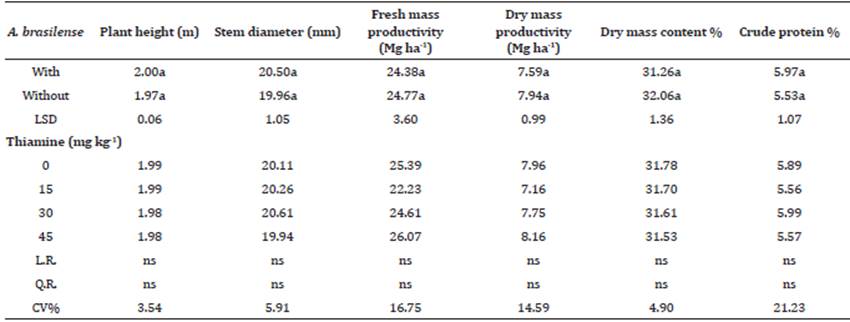
Same letters in a column indicate means are not significantly different at p < 0.05 by Tukey test. L.R. = linear regression; Q.R. = quadratic regression; LSD = least significant difference; CV = coefficient of variation.
Considering the production of silage as an extra product obtained by the use of sweet maize plants after ears harvest, a total operating cost of USD 228.36 was obtained (Table 2). This amount was composed of 5.71% for mechanized operations, 60.21% for manual operations and 34.08% for other costs. The large participation of manual operations over production costs is due to the high demand for labor to harvest the plants.
Table 2 Estimated total operational cost for silage produced from sweet maize plants treated with A. brasilense and thiamine in 10000 m2.
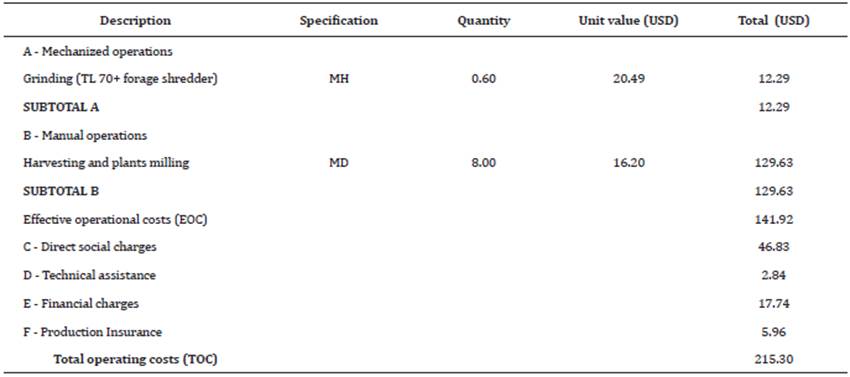
Considering the treatments separately, it was verified that A. brasilense and thiamine did not significantly interfere in production costs and did not reach a 1.00% participation over the total operational costs of silage production. The maximum increase observed was the application of A. brasilense, which raised costs by USD 1.49 ha1 (Table 3).
Table 3 Participation of the cost variation factors over the total operating cost for silage produced from sweet maize plants treated with A. brasilense and thiamine.

TOC = total operating costs; Th = thiamine; Az = Azospirillum brasilense.
It was observed that the economic indices followed the fresh matter productivity trend (Figure 2). In this sense, the utilization of A. brasilense increased in 24.36%, 24.36%, 53.15% and 10.47%, the productivity of fresh matter, gross revenue, operating profit and the profitability index, respectively, compared to the control treatment. In contrast, the combined treatment of A. brasilense and thiamine, at 15 mg L1, was the worst treatment, reducing the same variables in 8.74%, 8.74%, 20.07% and 5.61%, respectively.
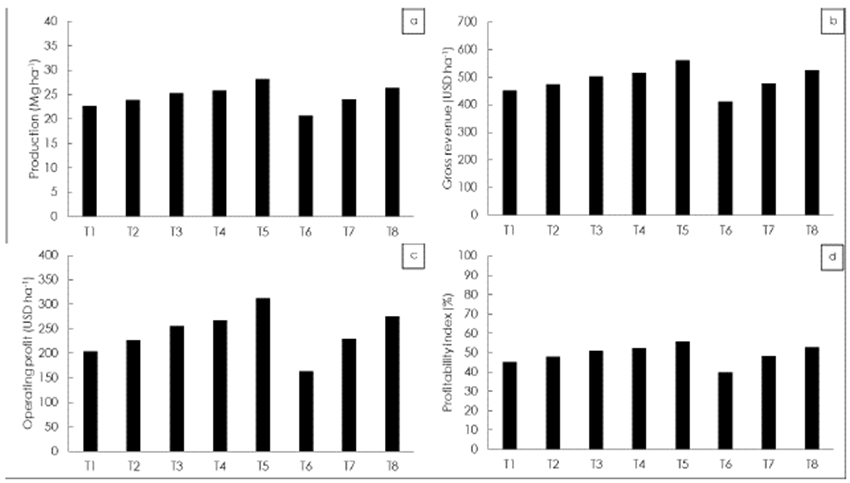
Figure 2 Productivity (a), gross revenue (b), operating profit (c) and profitability index (d) of silage produced from sweet maize plants treated with A. brasilense and thiamine. T1 = control; T2 = thiamine at 15 mg L-1; T3 = thiamine at 30 mg L-1; T4 = thiamine at 45 mg L-1; T5 = A. brasilense; T6 = A. brasilense + thiamine at 15 mg L-1; T7 = A. brasilense + thiamine at 30 mg L-1; T8 = A. brasilense + thiamine at 45 mg L-1.
The equilibrium productivity was unchanged by the use of thiamine and was raised by about 0.006% by the seeds inoculation with A. brasilense (Table 4). The highest equilibrium price was obtained with the treatment consisting of the treatment with A. brasilense and thiamine at a dose of 15 mg L1, which increased the variable by 10.27% in relation to the control treatment. However, there was a greater decrease in the equilibrium price, about 19.08%, when isolated inoculation was carried out with A. brasilense (Table 4). This indicates that the inoculation with A. brasilense reduces the effects of the oscillation of the values paid by the silage, giving more security to the producer.
DISCUSSION
The non-significant results observed for the biometric and productive characteristics (Table 1) corroborate other studies, in which the effectiveness of inoculation with Azospirillum bacteria on the biometric characteristics of maize plants was not observed when compared to the control treatment 17,18. It was also verified that the response of the maize plants to the inoculation is related to the genotype utilized since some materials present positive responses to shoot development, whereas others present an increase in the reproductive characteristics 19.
In studies about inoculation with A. brasilense on corn production it was verified that its use represents a factor of little expressive participation on the operational cost of production 5,6. However, in these same studies, the lack of response of the crop or even the variability of the effect in different culture conditions was verified.
In this sense, the positive results obtained for productivity of fresh matter, gross revenue, operating profit and the profitability index are related to the action of bacteria and their potential for the biological fixation of atmospheric nitrogen 3. This element is essential for the proper plant's development, as it participates in protein synthesis and photosynthetic activity, directly influencing the energy reserves accumulation in plant organs 10. The negative interaction between inoculation with A. brasilense and the application of thiamine as seed treatment is attributed to the protective effect triggered by the presence of the vitamin. Thiamine acts as a production inducer of secondary metabolites, responsible for the plant's protection against harmful action of biotic and abiotic factors 7;9;23;24. Thus, the presence of larger amounts of the vitamin may have increased the production of reactive oxygen species, as well as led to activation of genes related to the plants protection, as in the case of vine 7, culminating in lower plants development, due to the reaction to the presence of the endophytic bacteria. The signaling of a possible infection may also have caused the mobilization of reserves, once it is used in the plant's development 10.
It was also observed that the increase of thiamine doses, regardless of the presence or absence of A. brasilense, caused a tendency to increase the variables studied. This response to the application of the vitamin is related to its biostimulating character, increasing nutrient contents in the plants organs 9 and, consequently, favoring the development of the tissues, as verified for the mustard crop 25, quinoa 24 and common beans 26.
The means obtained for plant height were similar to those observed for different maize hybrids grown for silage production 20. For the same hybrids, it was observed that the average dry mass productivity per area, when the contribution of the ears was disregarded (7.12 Mg ha-1), was close to that obtained for sweet maize (7.77 Mg ha-1). However, crude protein levels are lower than those observed in other studies 21,22, result that is probably related to the cultivar characteristics, since absence of ears does not seem to significantly affect the protein content of the silage 27.
Despite the studies aimed at obtaining economic indexes for the maize crop and the effects of the inoculation of diazotrophic bacteria on the economic indexes of its production, no studies about the influence of thiamine on these same indexes were found. Thus, in possession of the results, the vitamin potential for use in crops of economic interest is verified, as a low cost alternative and with the capacity to increase economic gains. This can be seen for the sweet corn crop, for which a positive effect of the application of thiamine on the production and consequently on the monetary return on the sale of the product was verified 28,29.
Given what was observed in this study, it is important to carry out studies aiming to obtain the profitability indexes for techniques used in the commercial interest species production. In some cases, it is possible that even in the absence of statistical differences, changes in the economic variables can occur. This can be used to define the feasibility of implementing a technique or a product application to improve the production system conditions.
In conclusions A. brasilense and thiamine applied as seed treatment do not significantly affect sweet maize plants development and composition. Treatments influenced the economical indexes, and the isolated application of A. brasilense resulted in higher earnings. Thiamine isolated application as seed treatment can be used as an alternative for improvement of economical gains. In addition, the low cost of obtaining and using the studied products, makes their use in agricultural production feasible, making them promising technologies that demand more studies.














